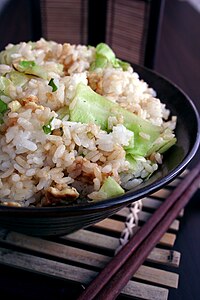Nasi goreng tionghoa: Perbedaan antara revisi
k Bot: Perubahan kosmetika |
Tidak ada ringkasan suntingan |
||
| (3 revisi perantara oleh 3 pengguna tidak ditampilkan) | |||
| Baris 27: | Baris 27: | ||
}} |
}} |
||
'''Nasi goreng tionghoa''' ({{zh|t=炒飯|s=炒饭|p=chǎofàn|j=caau<sup>2</sup> faan<sup>6</sup>|poj=chhá-pn̄g}}) merujuk kepada hidangan [[nasi goreng]] bergaya Tionghoa, yang terletak di [[Tiongkok Raya|negara-negara pemakai bahasa Tionghoa]] serta seluruh dunia. Makanan tersebut terkadang disajikan sebagai hidangan utama [[masakan Tionghoa|Tionghoa]],<ref>[http://eastasianpeoples.imb.org/stories/view/chinese-fried-rice-recipe Landing Page<!-- Bot generated title -->]</ref><ref>[https://www.ibiblio.org/chineseculture/contents/food/p-food-c01s01.html The Cultural Heritage of China |
'''Nasi goreng tionghoa''' ({{zh|t=炒飯|s=炒饭|p=chǎofàn|j=caau<sup>2</sup> faan<sup>6</sup>|poj=chhá-pn̄g}}) merujuk kepada hidangan [[nasi goreng]] bergaya Tionghoa, yang terletak di [[Tiongkok Raya|negara-negara pemakai bahasa Tionghoa]] serta seluruh dunia. Makanan tersebut terkadang disajikan sebagai hidangan utama [[masakan Tionghoa|Tionghoa]],<ref>[http://eastasianpeoples.imb.org/stories/view/chinese-fried-rice-recipe Landing Page<!-- Bot generated title -->]{{Pranala mati|date=Maret 2021 |bot=InternetArchiveBot |fix-attempted=yes }}</ref><ref>[https://www.ibiblio.org/chineseculture/contents/food/p-food-c01s01.html The Cultural Heritage of China:: Food & Drink:: Cuisine:: Introduction<!-- Bot generated title -->]</ref> tepat sebelum [[hidangan penutup]]. |
||
== Sejarah == |
== Sejarah == |
||
Asal muasal nasi goreng berkaitan dengan sejarah domestisasi padi di Tiongkok Selatan yang terjadi 8,200–13,500 tahun yang lalu.<ref name="pnas1">{{Cite journal | last1 = Molina | first1 = J. | last2 = Sikora | first2 = M. | last3 = Garud | first3 = N. | last4 = Flowers | first4 = J. M. | last5 = Rubinstein | first5 = S. | last6 = Reynolds | first6 = A. | last7 = Huang | first7 = P. | last8 = Jackson | first8 = S. | last9 = Schaal | first9 = B. A. | last10 = Bustamante | doi = 10.1073/pnas.1104686108 | first10 = C. D. | last11 = Boyko | first11 = A. R. | last12 = Purugganan | first12 = M. D. | title = Molecular evidence for a single evolutionary origin of domesticated rice | journal = Proceedings of the National Academy of Sciences | volume = 108 | issue = 20 | page = 8351 | year = 2011 | pmid = | pmc = | bibcode = 2011PNAS..108.8351M }}</ref> Catatan terawal dari nasi goreng bermula dari [[dinasti Sui]] (589–618 Masehi).<ref>{{cite web | title = Chinese Fried Rice | work = iFood.tv | url = http://ifood.tv/chinese/chinese-fried-rice/about}}</ref> Teknik [[menggoreng]] yang dipakai untuk memasak nasi goreng telah dicatat dalam periode sebelumnya, |
Asal muasal nasi goreng berkaitan dengan sejarah domestisasi padi di Tiongkok Selatan yang terjadi 8,200–13,500 tahun yang lalu.<ref name="pnas1">{{Cite journal | last1 = Molina | first1 = J. | last2 = Sikora | first2 = M. | last3 = Garud | first3 = N. | last4 = Flowers | first4 = J. M. | last5 = Rubinstein | first5 = S. | last6 = Reynolds | first6 = A. | last7 = Huang | first7 = P. | last8 = Jackson | first8 = S. | last9 = Schaal | first9 = B. A. | last10 = Bustamante | doi = 10.1073/pnas.1104686108 | first10 = C. D. | last11 = Boyko | first11 = A. R. | last12 = Purugganan | first12 = M. D. | title = Molecular evidence for a single evolutionary origin of domesticated rice | journal = Proceedings of the National Academy of Sciences | volume = 108 | issue = 20 | page = 8351 | year = 2011 | pmid = | pmc = | bibcode = 2011PNAS..108.8351M }}</ref> Catatan terawal dari nasi goreng bermula dari [[dinasti Sui]] (589–618 Masehi).<ref>{{cite web | title = Chinese Fried Rice | work = iFood.tv | url = http://ifood.tv/chinese/chinese-fried-rice/about}}</ref> Teknik [[menggoreng]] yang dipakai untuk memasak nasi goreng telah dicatat dalam periode sebelumnya, tetapi tidak sampai akhir [[dinasti Ming]] (1368–1644 Masehi) saat teknik tersebut makin populer.<ref>{{cite book | title = Stir-Frying to the Sky's Edge: The Ultimate Guide to Mastery, with Authentic Recipes and Stories | author = Grace Young | publisher = Simon and Schuster | year = 2010 | isbn = 9781416580577| url = https://books.google.com/books?id=buSaBAAAQBAJ&pg=PA49&lpg=PA49&dq=Stir+frying+Ming+dynasty&source=bl&ots=xiKcdOGTvv&sig=AG0MqnXj4zQOwIX0s710CN4zE40&hl=id&sa=X&ved=0ahUKEwj_muTIhu7SAhXIp48KHWzoCeIQ6AEIRjAG#v=onepage&q=Stir%20frying%20Ming%20dynasty&f=false | page = 49}}</ref> |
||
== Lihat pula == |
== Lihat pula == |
||
| Baris 39: | Baris 39: | ||
[[Kategori:Hidangan nasi]] |
[[Kategori:Hidangan nasi]] |
||
[[Kategori:Nasi goreng]] |
|||
[[Kategori:Hidangan Tionghoa]] |
|||
Revisi terkini sejak 15 April 2024 13.00
| Nasi goreng Tionghoa | |
|---|---|
 | |
| Jenis | Nasi goreng |
| Tempat asal | Tiongkok |
| Daerah | Tiongkok Raya |
| Bahan utama | Nasi |
| Variasi | Nasi goreng Hokkien, nasi goreng Yangzhou, nasi goreng yin yang |
Nasi goreng tionghoa (Hanzi sederhana: 炒饭; Hanzi tradisional: 炒飯; Pinyin: chǎofàn; Jyutping: caau2 faan6; Pe̍h-ōe-jī: chhá-pn̄g) merujuk kepada hidangan nasi goreng bergaya Tionghoa, yang terletak di negara-negara pemakai bahasa Tionghoa serta seluruh dunia. Makanan tersebut terkadang disajikan sebagai hidangan utama Tionghoa,[1][2] tepat sebelum hidangan penutup.
Sejarah
[sunting | sunting sumber]Asal muasal nasi goreng berkaitan dengan sejarah domestisasi padi di Tiongkok Selatan yang terjadi 8,200–13,500 tahun yang lalu.[3] Catatan terawal dari nasi goreng bermula dari dinasti Sui (589–618 Masehi).[4] Teknik menggoreng yang dipakai untuk memasak nasi goreng telah dicatat dalam periode sebelumnya, tetapi tidak sampai akhir dinasti Ming (1368–1644 Masehi) saat teknik tersebut makin populer.[5]
Lihat pula
[sunting | sunting sumber]Referensi
[sunting | sunting sumber]- ^ Landing Page[pranala nonaktif permanen]
- ^ The Cultural Heritage of China:: Food & Drink:: Cuisine:: Introduction
- ^ Molina, J.; Sikora, M.; Garud, N.; Flowers, J. M.; Rubinstein, S.; Reynolds, A.; Huang, P.; Jackson, S.; Schaal, B. A.; Bustamante, C. D.; Boyko, A. R.; Purugganan, M. D. (2011). "Molecular evidence for a single evolutionary origin of domesticated rice". Proceedings of the National Academy of Sciences. 108 (20): 8351. Bibcode:2011PNAS..108.8351M. doi:10.1073/pnas.1104686108.
- ^ "Chinese Fried Rice". iFood.tv.
- ^ Grace Young (2010). Stir-Frying to the Sky's Edge: The Ultimate Guide to Mastery, with Authentic Recipes and Stories. Simon and Schuster. hlm. 49. ISBN 9781416580577.


